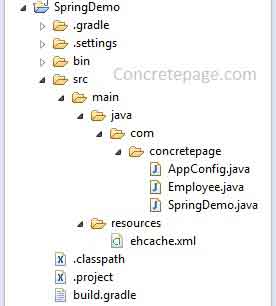Spring 4 Ehcache Configuration Example with @Cacheable Annotation
http://www.concretepage.com/spring-4/spring-4-ehcache-configuration-example-with-cacheable-annotation
Spring 4 Ehcache Configuration Example with @Cacheable Annotation
In this page, we will learn Spring 4 Ehcache configuration example with @Cacheable annotation. Ehcache manages cache for boosting performance. Spring provides @Cacheable annotation that uses cache name defined in Ehcache xml file. Spring provides EhCacheManagerFactoryBean and EhCacheCacheManager classes to configure and instantiate Ehcache. The configuration class must be annotated with @EnableCaching annotation which enables annotation driven cache management. Here we will provide a complete example for Spring Ehcache Configuration.
build.gradle
Find the Gradle file to resolve JAR dependency for Spring and Ehcache.
build.gradle
apply plugin: 'java'
apply plugin: 'eclipse'
archivesBaseName = 'concretepage'
version = '1'
repositories {
mavenCentral()
}
dependencies {
compile 'org.springframework.boot:spring-boot-starter:1.2.2.RELEASE'
compile 'org.springframework:spring-context-support:4.1.5.RELEASE'
compile 'net.sf.ehcache:ehcache-core:2.6.10'
}
Project Structure in Eclipse
Find the project structure in eclipse that will help to learn fast.

Configuration Class for EhCacheManagerFactoryBean and EhCacheCacheManager
The configuration class will be annotated with @EnableCaching annotation and we need to create bean for EhCacheManagerFactoryBean and EhCacheCacheManager class.
@EnableCaching: It enables annotation driven cache management in spring and is same as using<cache:annotation-driven />.
EhCacheManagerFactoryBean: Assign ehcache XML file by calling EhCacheManagerFactoryBean.setConfigLocation(). By passing true to setShared() method, we enable our cache to be shared as singleton at the ClassLoader level. By default it is set to false.
EhCacheCacheManager: This is a CacheManager backed by an EhCache. We can instantiate it by passing argument of EhCacheManagerFactoryBean.getObject().
Find the Configuration file.
AppConfig.java
package com.concretepage;
import org.springframework.beans.factory.annotation.Configurable;
import org.springframework.cache.CacheManager;
import org.springframework.cache.annotation.EnableCaching;
import org.springframework.cache.ehcache.EhCacheCacheManager;
import org.springframework.cache.ehcache.EhCacheManagerFactoryBean;
import org.springframework.context.annotation.Bean;
import org.springframework.core.io.ClassPathResource;
@Configurable
@EnableCaching
public class AppConfig {
@Bean
public Employee getEmployee(){
return new Employee();
}
@Bean
public CacheManager getEhCacheManager(){
return new EhCacheCacheManager(getEhCacheFactory().getObject());
}
@Bean
public EhCacheManagerFactoryBean getEhCacheFactory(){
EhCacheManagerFactoryBean factoryBean = new EhCacheManagerFactoryBean();
factoryBean.setConfigLocation(new ClassPathResource("ehcache.xml"));
factoryBean.setShared(true);
return factoryBean;
}
}
The equivalent ehcache configuration in spring xml is given below.
<cache:annotation-driven />
<bean id="employee" class="com.concretepage.Employee"/>
<bean id="cacheManager" class="org.springframework.cache.ehcache.EhCacheCacheManager"
p:cache-manager-ref="ehcache"/>
<bean id="ehcache" class="org.springframework.cache.ehcache.EhCacheManagerFactoryBean"
p:config-location="classpath:ehcache.xml" p:shared="true"/>
ehcache.xml
Find the sample ehcache.xml file. We have created a cache with the name empcache that will be used by spring @Cacheable annotation. Here maximum 5000 elements will be cached in memory and after that it will overflow to local disk. Any element will expire if it is idle for more than 200 seconds and alive for more than 500 seconds.
ehcache.xml
<?xml version="1.0" encoding="UTF-8"?>
<ehcache xmlns:xsi="http://www.w3.org/2001/XMLSchema-instance"
xsi:noNamespaceSchemaLocation="ehcache.xsd"
updateCheck="true" monitoring="autodetect" dynamicConfig="true">
<cache name="empcache"
maxEntriesLocalHeap="5000"
maxEntriesLocalDisk="1000"
eternal="false"
diskSpoolBufferSizeMB="20"
timeToIdleSeconds="200"
timeToLiveSeconds="500"
memoryStoreEvictionPolicy="LFU"
transactionalMode="off">
<persistence strategy="localTempSwap"/>
</cache>
</ehcache>
Using @Cacheable on Bean Method
If we annotate our bean method by Spring @Cacheable annotation, it declares that it will be cached. We need to provide cache name defined in ehcache.xml. In our example we have a cache named as empcache in ehcache.xml and we have provided this name in @Cacheable. Spring will hit the method for the first time. The result of this method will be cached and for same argument value, spring will not hit the method every time. Once the cache is expired, then the spring will hit the method again for the same argument value.
Employee.java
package com.concretepage;
import org.springframework.cache.annotation.Cacheable;
public class Employee {
@Cacheable("empcache")
public String getEmployee(int empId){
System.out.println("---Inside getEmployee() Method---");
if(empId==1){
return "Shankar";
}else{
return "Vishnu";
}
}
}
Test Spring Ehcache Application
Now we create a main method to test the application. Here if we call the method passing a value as an argument for the first time, spring will hit the method. And for next hit, if we pass the same argument value, we will get result from cache not by running method.
SpringDemo.java
package com.concretepage;
import org.springframework.context.annotation.AnnotationConfigApplicationContext;
public class SpringDemo {
public static void main(String... args) {
AnnotationConfigApplicationContext ctx = new AnnotationConfigApplicationContext();
ctx.register(AppConfig.class);
ctx.refresh();
Employee employee=(Employee) ctx.getBean(Employee.class); //calling getEmployee method first time.
System.out.println("---Fetch Employee with id 1---");
System.out.println("Employee:"+ employee.getEmployee(1)); //calling getEmployee method second time. This time, method will not execute.
System.out.println("---Again Fetch Employee with id 1, result will be fetched from cache---");
System.out.println("Employee:"+employee.getEmployee(1)); //calling getEmployee method third time with different value.
System.out.println("---Fetch Employee with id 2---");
System.out.println("Employee:"+employee.getEmployee(2));
}
}
Find the output.
17:06:49.301 [main] DEBUG o.s.b.f.s.DefaultListableBeanFactory - Returning cached instance of singleton bean 'getEmployee'
---Fetch Employee with id 1---
---Inside getEmployee() Method---
17:06:49.323 [main] DEBUG net.sf.ehcache.store.disk.Segment - put added 0 on heap
Employee:Shankar
---Again Fetch Employee with id 1, result will be fetched from cache---
Employee:Shankar
---Fetch Employee with id 2---
---Inside getEmployee() Method---
17:06:49.327 [main] DEBUG net.sf.ehcache.store.disk.Segment - put added 0 on heap
Employee:Vishnu
17:06:49.332 [empcache.data] DEBUG net.sf.ehcache.store.disk.Segment - fault removed 0 from heap
17:06:49.332 [empcache.data] DEBUG net.sf.ehcache.store.disk.Segment - fault added 0 on disk
Spring 4 Ehcache Configuration Example with @Cacheable Annotation的更多相关文章
- Spring整合EHCache框架
在Spring中使用缓存可以有效地避免不断地获取相同数据,重复地访问数据库,导致程序性能恶化. 在Spring中已经定义了缓存的CacheManager和Cache接口,只需要实例化便可使用. Spr ...
- Spring整合Ehcache管理缓存
前言 Ehcache 是一个成熟的缓存框架,你可以直接使用它来管理你的缓存. Spring 提供了对缓存功能的抽象:即允许绑定不同的缓存解决方案(如Ehcache),但本身不直接提供缓存功能的实现.它 ...
- Spring整合Ehcache管理缓存(转)
目录 前言 概述 安装 Ehcache的使用 HelloWorld范例 Ehcache基本操作 创建CacheManager 添加缓存 删除缓存 实现基本缓存操作 缓存配置 xml方式 API方式 S ...
- 缓存插件 Spring支持EHCache缓存
Spring仅仅是提供了对缓存的支持,但它并没有任何的缓存功能的实现,spring使用的是第三方的缓存框架来实现缓存的功能.其中,spring对EHCache提供了很好的支持. 在介绍Spring的缓 ...
- Spring整合EhCache详解
一.EhCache介绍 EhCache 是一个纯Java的进程内缓存框架,具有快速.精干等特点,是Hibernate中默认的CacheProvider.Ehcache是一种广泛使用的开 源Java分布 ...
- 以Spring整合EhCache为例从根本上了解Spring缓存这件事(转)
前两节"Spring缓存抽象"和"基于注解驱动的缓存"是为了更加清晰的了解Spring缓存机制,整合任何一个缓存实现或者叫缓存供应商都应该了解并清楚前两节,如果 ...
- spring中ehcache的配置和使用方法
继续上篇,这篇介绍服务层缓存,ehcache一般的配置和用法 一.添加jar包引用 修改pom.xml文件,加入: <dependency> <groupId>org.spri ...
- spring+shiro+ehcache整合
1.导入jar包(pom.xml文件) <!-- ehcache缓存框架 --> <dependency> <groupId>net.sf.ehcache</ ...
- Unit Testing of Spring MVC Controllers: Configuration
Original Link: http://www.petrikainulainen.net/programming/spring-framework/unit-testing-of-spring-m ...
随机推荐
- 018如何建立自动化框架 how to bulid the framwork
本讲包括: 一. objective 二. How to bulid 三. Keyview of frawork (关键视图) 四. conclusion automation framwork:自动 ...
- Zabbix探索:使用msmtp进行邮件告警
在Nagios时代就已经使用msmtp发送告警了,不过那时候偷懒,使用mutt发送来简化格式. 在Zabbix时代,更多人使用msmtp,所以官方论坛上有个zext_msmtp.sh的脚本,但是不要以 ...
- Linq 两个集合模糊查询
1.Linq的likelist<string> l=new list<string>();l.add("ss")l.add("ss123" ...
- CentOS上安装MySQL
1.准备RPM安装包 MySQL-server-5.6.33-1.linux_glibc2.5.x86_64 MySQL-client-5.6.33-1.linux_glibc2.5.x86_64 2 ...
- 给定金额m和红包数量n
这一题如果是采用暴力手段,不一定能获得正确答案,而且也非常耗时. 所以下面我们采用一个小技巧,也就是先产生n-1个红包,总得sum<m的,这样最后只要添加一个sum-m的红包钱数就可以了. 具体 ...
- 声明了包的类Java命令找不到或无法加载主类
首先你需要配置环境变量: CLASSPATH=.;%JAVA_HOME%/lib/dt.jar;%JAVA_HOME%/lib/tools.jar java 命令会在 CLASSPATH 目录下找相应 ...
- 让UILabel具有链接功能,点击后调用safari打开网址
UILabel *labelGovUrl = [[UILabel alloc] initWithFrame:CGRectMake(73.0, 330.0, 180.0, 40.0)]; labelGo ...
- SignalTap II逻辑分析仪的使用
一.例子 我们使用如图1所示的verilog代码所实现的开关电路作为例子.这个电路把DE系列开发板上的前8个开关简单的和对应的8个红色LED相连接.它是这样工作的:在时钟(CLOCK_50)的上升沿读 ...
- 【Stage3D学习笔记续】山寨Starling(一):从事件说起
我在GitHub上新开了一个项目:https://github.com/hammerc/hammerc-study-Stage3D 山寨的Starling版本我取名叫做Scorpio2D,以后的笔记中 ...
- ajax请求,请求头是provisional are shown。请求未发送出去
问题: ajax请求,请求没成功.ajax请求没有发送出去. 查看network,看到请求头处:Provisional headers are shown. 原因: 搜索了一下,网上说了几个原因. 1 ...
